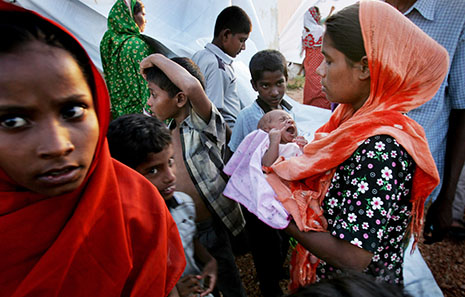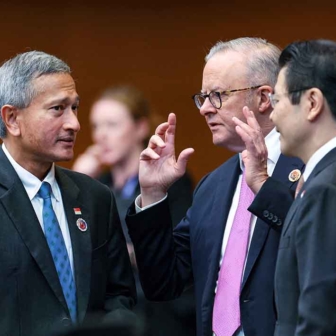THE BRUTAL Sri Lankan civil war, which took nearly 100,000 lives and seemed so intractable, came to a sudden end in May this year. Sri Lankan government forces crushed the decades-old separatist campaign waged by the Liberation Tigers of Tamil Eelam and killed its elusive and ruthless leader, Velupillai Prabhakaran.
But although the military victory was absolute, Sri Lanka remains on a war footing. Half a million Tamils are detained in military controlled camps and army checkpoints still operate in Colombo and Jaffna. Overheated reports in the government-run media allege that local and conspiracies are plotting to bring about, by political means, the very division of the country that the Tamil Tigers could not achieve militarily.
Meanwhile, questions about how the victory was won continue to dog the military and the government, and details of China’s little-known role in the conflict are coming to light. International human rights groups, the United Nations and the European Union have all called for independent inquiries into the deaths of an estimated 7000 Tamil civilians in the final months of the war, when a ferocious, and some claim indiscriminate, bombing campaign was conducted away from the eyes of the world’s media.
The government claims that the civilian casualties occurred because the Tigers’ leaders were making hostages of their own people, using them as a human shield as the army advanced on their final stronghold. And it is certainly well documented that the Tigers forcibly recruited child soldiers into their ranks and, as the war turned against them, their cadres retreated into Tamil villages. But Gordon Weiss, the UN’s humanitarian coordinator in Sri Lanka, suggests that the government’s numbers just don’t add up. General Sarath Fonseka, who led the Sri Lankan army, has claimed that 22,000 Tigers were killed in the final two years of the war, yet in 2006 he claimed that the organisation had only 10,000 cadres in total. Who, then, were the other casualties?
The barrage of criticism has not abated. The foreign ministers of the European Union have been threatening to withdraw Sri Lanka’s preferential trade status if it doesn’t show rapid and serious improvement in human rights. Meeting on 29 October in Luxembourg, the ministers said that the European Union “remains seriously concerned with continuing reports of abductions, disappearances and extra judicial killings. The organisation is also gravely concerned about reports of severe harassment of journalists, restrictions on freedom of the press and freedom of expression in Sri Lanka.”
Also in October, the US State Department presented a report to Congress detailing alleged incidents during the final months of the war in Sri Lanka “that may constitute violations of humanitarian law or crimes against humanity and related harms.” The report alleges that both the Tigers and the government may have been responsible for the deaths of thousands of civilians.
Yet the government continues to maintain that the armed forces were scrupulous in protecting civilians. Responding to the congressional report, the Sri Lankan foreign ministry fell back on conspiracy theories, alleging that “there is a track record of vested interests endeavouring to bring the government of Sri Lanka into disrepute, through fabricated allegations and concocted stories.”
And the role of China? It was Beijing that underwrote Sri Lanka’s war against the Tigers, giving the government the aid, armaments and diplomatic support it needed to win the war without having to worry about criticisms from the West. When the United States stopped direct aid to Sri Lanka because of its human rights record in 2007, Beijing came to Colombo’s rescue. Meanwhile, India – Sri Lanka’s main ally and the major power in South Asia – had been sidelined by an internal debate that pitted support for ethnic Tamils against regional power considerations.
Armaments from China (and from their ally Pakistan) gave the government the firepower to smash the Tigers’ highly trained war machine. Sri Lanka signed a $37 million deal to procure Chinese ammunition and ordnance for its army and navy in April 2007. Many of the arms were bought through Lanka Logistics & Technologies, which operates under the defence secretary, Gotabhaya Rajapaksa, who is also the president’s brother. Chinese Jian-7 fighter jets, anti-aircraft guns and JY-11 3D air surveillance radars all played a central role in achieving the military victory.
In 2008 China gave Sri Lanka an astonishing “gift” of six F7 jet fighters after a daring raid by the Tigers’ air wing had destroyed ten military aircraft in the previous year. China is now the biggest foreign donor to Sri Lanka with almost $1 billion donated last year, up from just a few million in 2005. China also provided vital diplomatic support in the UN Security Council, using its veto to block efforts to put Sri Lanka on the agenda. The Sri Lankan government could afford to ignore criticism with China in its corner.
So, what does China get in return for all this largesse? The Times of India reports that China is building a $1 billion port near the town of Hambantota in the south. China says this is a purely commercial venture, but Indian and American analysts see this as part of China’s “string of pearls” strategy for gaining a foothold across the region. From Pakistan through Bangladesh to Burma, China’s growing influence takes the form of listening posts, special naval arrangements and access to ports to control crucial passageways for trade and oil between the Indian and Pacific oceans. Oil from the Middle East must pass this way and China now has an extra refuelling and docking station for its navy.
ALMOST six months after the end of the war the most urgent and contentious issue is the fate of almost 250,000 internally displaced people. These Tamil families are non-combatants who once lived under the tutelage of the Tamil Tigers in the de-facto state it carved out of the north and east of Sri Lanka. They have been the innocents caught in the crossfire, and they had been displaced many times before as the war raged around them. Now, they are incarcerated in government detention camps as the monsoon rains descend, bringing fears of disease and death. Claims of disappearances and maltreatment abound.
The government argues that these people cannot return to their villages for two reasons: time is required to de-mine areas that were recently the site of a ferocious war; and, it argues, Tigers cadres hiding among the civilians must be weeded out as a matter of national security. President Rajapaksa has outlined a plan to resettle “70 to 80 per cent” of the displaced people by January, but there are doubts as to whether the government intends to keep its promise.
The UN human rights representative, Walter Kaelin, has insisted that the displaced people should be processed quickly and allowed to return to their homes or to host families in the community. The International Crisis Group told the European parliament in early October that “such restrictions on freedom in the absence of due process are a violation of both national and law.”
The incarceration of Tamil civilians by the government is highly sensitive and symbolic. Among the huge Tamil diaspora scattered across Canada, Britain, Europe and Australia, the fate of the internally displaced civilians is viewed as a litmus test of how Tamils will fare under majority Sinhalese rule unhindered by any countervailing force. In essence, the diaspora supported the fight for Tamil rights, even if a majority may have abhorred the methods used by the Tigers to prosecute their case. A failure by the government to free the internally displaced and treat them as respected citizens might well fuel support for a renewed armed struggle.
A corollary is that President Rajapaksa may have trouble turning off his huge war machine. The army is more powerful than ever, and the fragile institutions of democracy, which suffered major damage during the all-out war, are still weak and ineffective. Civil society is largely silent and fearful in the face of the arrests and killings of those who have dared to question the way the war was won. Dissenting opinion is portrayed as unpatriotic and subversive. Months after the war ended, according to Amnesty International, journalists and media workers are still facing murder, abduction, censorship and intimidation. The majority of victims are Tamils, but Sinhalese and Muslim journalists have also been killed. The perpetrators of many of these crimes have not been identified, let alone punished.
And yet the government appears to be more popular than ever. A string of recent provincial election victories has raised the possibility of early national polls. President Rajapaksa may also call forward the presidential poll, due in 2011, to cash in on his own popularity as a strong man. Some commentators even suggest that the hubris of the president might lead to constitutional changes aimed at extending his hold on power beyond his second term.
In a statement on Sri Lanka to the Australian parliament on 14 September, the foreign affairs minister, Stephen Smith, spoke of the urgent need to resettle the internally displaced Sri Lankans and to move towards political reconciliation. “Australia has consistently stated that the solution to the conflict was never going to be by military means alone,” he said. “The time is here for the Sri Lankan government to win the peace and to forge an enduring political settlement for all Sri Lankans. This will require political reform and rapprochement between all parties and communities.”
These are wise words from a friend of the Sri Lankan people. But if Australia is to remain a friend then it must accept that internally displaced people, and others like them from Afghanistan or Iraq, have a right to make their claims for asylum under the refugee convention, which Australia and over 140 other countries have signed and ratified.
As a member of the group of traditional western donors to Sri Lanka, Australia can also lead the way towards a consensus on postwar reconstruction aid in Sri Lanka, working with Japan, the European Union, the United States, the Asian Development Bank and the World Bank. Considerable political leverage could be used to insist that the Sri Lankan government creates the necessary conditions for inclusive, equitable and sustainable development. Low interest loans and grants tied to good governance and transparency will also assist in re-building the democratic infrastructure of the war-torn state.
In the final stages of the war China and Iran came to Sri Lanka’s rescue with loans, albeit at commercial rates of interest. Over a billion dollars in support and investment from each of these giants almost silenced the human rights protestations of Australia and its partners. There is important diplomatic work to be done to help Sri Lanka re-build its relationships and its trust in its traditional allies.
For most Sri Lankans the end of this violent and exhausting civil war is to be celebrated if it means that peace can prevail. But peace is more than just an absence of war. A lasting peace requires that economic and social reconstruction and true reconciliation must now begin in earnest. As the International Crisis Group puts it: “The government should initiate a new and inclusive process of dialogue between legitimate and independent representatives of all ethnic communities in pursuit of a lasting political settlement that addresses the grievances and insecurities of all communities through constitutional guarantees of power-sharing and individual rights.”
Behind the euphoria of military victory lies an unspoken fear. This is the fear that after all this bloodshed, peace may turn out to be illusory after all. Sri Lanka may only be in a hiatus before the awful violence resumes again. This may be the fear that drives people onto leaky boats seeking refuge elsewhere. The government of President Rajapaksa is yet to consolidate the peace by healing the wounds of war that so deeply divide this multi-ethnic, multi-lingual and multi-faith society. •
Larry Marshall is a researcher in the Politics Department at La Trobe University. He was born in Sri Lanka.




